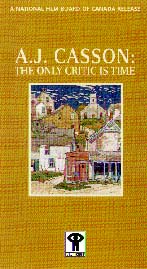|
________________
CM . . . .
Volume V Number 17 . . . . April 23, 1999
excerpt: If I can get across to the person who's viewing it the way I felt that day about it, I'm happy. Carmichael always impressed upon me that painting should be a pleasure. Mind you, it's a lot of hard work, but he always said that if it became nothing but hard work, stop.These words by the artist, Alfred Joseph Casson (1898-1992) in the video A.J. Casson: The Only Critic is time hint both at his pragmatic outlook and his close association with the Group of Seven of whom he was the youngest and longest surviving original member. The video presents a roughly chronological view of his life, placed in the context of Canadian art and history. Through the commentaries of a range of people (a narrator, a former employer, an art gallery curator and A.J. Casson, himself), viewers learn about some of the landmarks in the Toronto-born artist's life and career: his apprenticeship in a printing shop at 15; his early art education; his "keeping bad company" with the Group of Seven, known for their experimental style of painting the Canadian north; his growing success as both a commercial artist and, finally, his decision at 62 to become a full-time painter in search of a personal style. It is interesting that Casson was able to straddle the worlds of both establishment and experimental art: in 1926, remarkably, he became a member of the conservative Royal Canadian Academy and the radical Group of Seven! Casson's decision to focus more on small town Canada as his subject matter, rather than the wilds of the north, likely contributed to his popularity. This ability to please a wide range of viewers was the basis of Casson's success, but it was also, later, a source of frustration for him as he tried to break away from the influence of other artists and define a more authentic style for himself. The most fascinating passages in the video are the ones featuring A.J. Casson reminiscing in a very matter-of-fact way about events in his past and about the choices, artistic and practical, he had to make along the way. Viewers see and listen to him (chainsmoking) in his study, in his garden in Toronto, and at work in his studio or on location. Near the end of the video, in an attempt to evaluate his own nature as an artist, Casson is typically modest and non-controversial: his view is that "the only critic is time." The video intersperses a variety of important images among the interviews: a chronological survey of Casson's sketches, watercolours, oil paintings and commercial work (including Mobil Oil posters and Macleans covers); old photos of family, friends and fellow artists and film clips of gallery openings. The soundtrack for the video (restful flute/piano/orchestral music) supports the nostalgic mood of Casson's paintings and the understated personality of the artist himself. A.J. Casson: The Only Critic is Time would probably appeal to older students and adults. It provides, for one thing, a glimpse into a significant period in Canadian art history, a time when artists and writers were struggling with the notion of a Canadian "identity." It also illustrates the life - with all its decisions, challenges, frustrations, and triumphs - of an individual artist and can thus serve as a case to be studied by those contemplating careers in art. Recommended. Ann Stinner is an art education instructor in the Faculty of Education, the University of Manitoba.
To comment on this title or this review, send mail to cm@umanitoba.ca.
Copyright © the Manitoba Library Association.
Reproduction for personal use is permitted only if this copyright notice
is maintained. Any other reproduction is prohibited without
permission.
Published by
TABLE OF CONTENTS FOR THIS ISSUE - APRIL 23,
1999.
AUTHORS |
TITLES |
MEDIA REVIEWS |
PROFILES |
BACK ISSUES |
SEARCH |
CMARCHIVE |
HOME
|

